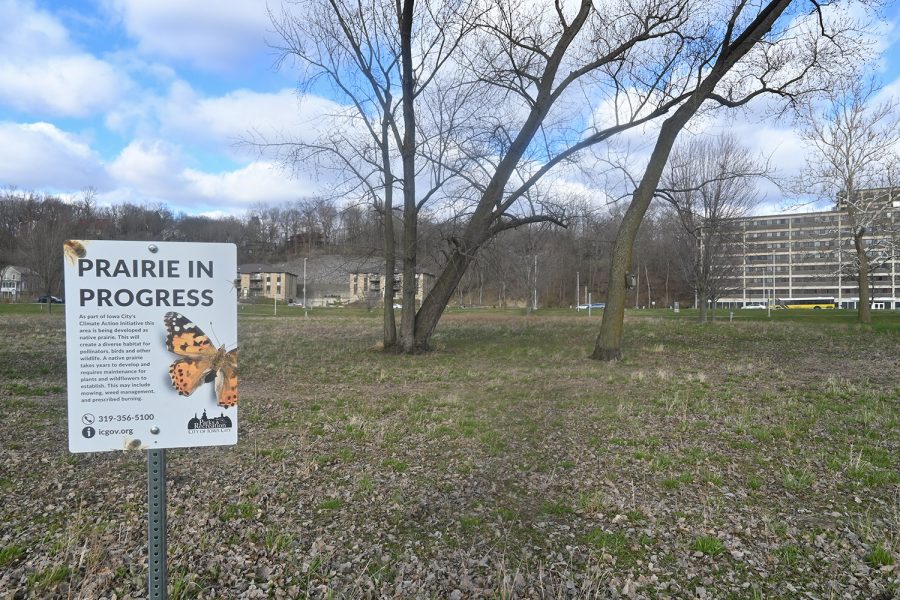New Terrell Mill Park prairie to contribute to Iowa City climate goals
Iowa City is planting prairies to fulfill its climate goals, including the addition of plants native to the area across from Mayflower Residence Hall.
The prairie in Mayflower Park in Iowa City is seen on Monday, April 18, 2022.
April 18, 2022
A new prairie in Terrell Mill Park off Dubuque Street features plants native to Iowa as part of a city-wide effort to reduce carbon emissions.
Across the street from Mayflower Residence Hall, the prairie is one of Iowa City’s many planted by the city to contribute to the city’s Climate Action Plan.
Tyler Baird, superintendent of parks and forestry for Iowa City, has oversight over the prairie project across from Mayflower Residence Hall, alongside the other 25 prairies currently being grown in Iowa City.
The process for developing a prairie in Terrell Mill Park began in August 2020, and seeds were officially planted in November of that year, Baird said, which will take three to five years to be fully grown.
The Terrell Mill Park planting will add to the number of prairies already managed by the city, Baird added.
“We’ve been growing prairies over the last four years, and we’ve added somewhere around 150 acres of prairies so far,” Baird said.
The prairies were added in about 25 different locations, Baird said, including Scott Park, the Kicker Soccer Complex, Waterworks Prairie Park, and the new prairie being grown at Terrell Mill Park.
Former Iowa City Mayor Jim Throgmorton wrote in a public letter to Iowa City residents in 2019 stating the hopes had for the city’s economic and environmental future.
“The Plan offers a way to turn the threats posed by global climate change into an opportunity: to build an economy and community that will sustain us and other living creatures long into the future,” former Iowa City Mayor Jim Throgmorton wrote in a public letter to Iowa City residents in 2019.
Iowa City Climate Action Coordinator Sarah Gardner said the plan has set out main goals and has been working to complete them since the initial plan was developed in 2016.
“Two of our main goals are to reduce emissions by 45 percent by 2030, and to achieve net-zero emission by 2050,” Gardner said. “We have already succeeded in reducing emissions by 45 percent.”
Gardner said this is partly because of the influx of prairies being grown in the city, for a variety of reasons.
“The prairies do a couple things, one of the biggest things is that they help sequester carbon by pulling it into the air and getting it out of the ground,” she said.
Gardner said a lot of people are unaware prairies are more effective than trees at sequestering carbon, because trees tend to store the carbon in the branches and leaves while prairies store the carbon in their roots.
When those leaves fall down, they get washed away and usually aren’t reabsorbed into the ground, she said.
“The prairies also require much less mowing to retain them, which helps reduce the emissions of lawn care equipment,” Gardner said. “Because of their deep rootedness, they also help with stormwater mitigation.”
Throgmorton wrote that for the plan to succeed, all parties must move forward in a common direction and while the city will establish partnerships with several organizations and businesses, it will seek opinions from Iowa City residents, as well.
Gardner said when the city proposed putting solar panels into the Waterworks Prairie Park in 2020, residents suggested the city think about putting the solar panels in a different location.
“It showed us that people do care a lot about those prairie plantings and have come to like them very much,” Gardner said.



